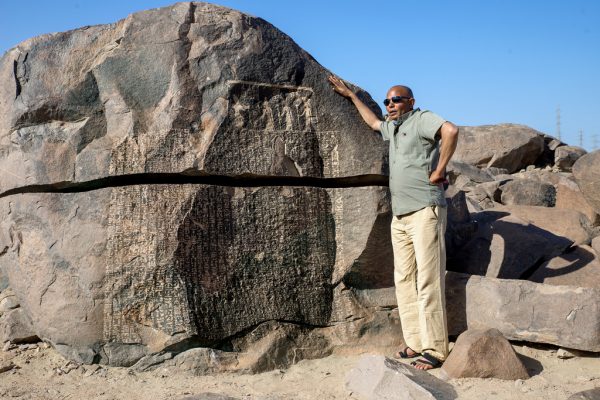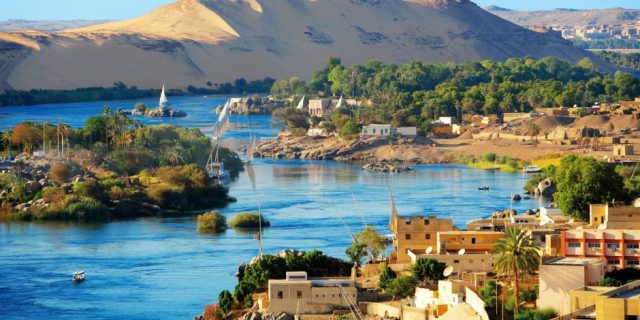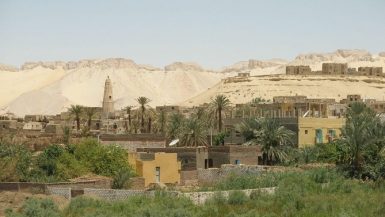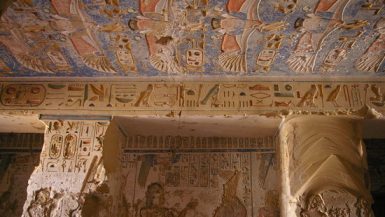Sehel Island | Ankh |
The Island of Sehel is about 4km south of Aswan, in the Nile to the north of the old Aswan Dam. In ancient times travellers on their way to Nubia, or who had just returned from an expedition to the south, would make a pilgrimage to the sacred Sehel island and leave inscriptions recording their appeals or prayers of gratitude for help in safely negotiating the hazardous first Nile cataract.
Several of them record events and journeys into Nubia by officials on the king’s business. The inscriptions are carved or bruised onto the jumbled mounds of granite boulders which are strewn over several areas of the island.
Flinders Petrie visited Sehel in 1887 taking photographs and making sketches of the thousands of inscriptions he found on the boulders and cliffs by climbing rope ladders.
Sehel Island
The two hills which dominate the south-eastern end of the island boast over 250 inscriptions, many of which are dedicated to the goddess Anukis and her consort Khnum and date from the Middle Kingdom to Ptolemaic periods.
A chapel dedicated to Anukis was built at the time of Amenemhet II during Dynasty XII but little remains of this structure, while remaining blocks from a small Ptolemaic temple of Khnum were found scattered around the Nubian village.
Anukis was a goddess worshipped in the area of the Egyptian border and sometimes known as ‘Mistress of Nubia’. She was associated with the cataracts at Aswan and specifically with the islands of Sehel and Elephantine.
A protective and fertility deity, Anukis was also thought to be a personification of the Nile who embraced the waters of the inundation. Her husband Khnum, a ram-headed creator god who is often shown fashioning the ka of the king on his potters wheel, was also seen as a potent fertility god under whose protection the cataract region came.
Khnum And Anukis
The boulders in the monument areas are now enclosed by a metal fence. The path up from the river takes you past a section to the west with some nice inscriptions and a larger hill to the east for which a ticket is required at the entrance.
Here you will see a great number of well-preserved carvings with hieroglyphic inscriptions dedicated to Khnum, Anukis and other deities and several royal cartouches.
As you climb the hill to the top there is a spectacular view over the cataract area to the south. The cataracts are rocky areas of boulders in the narrow channels of the River Nile which until a century or so ago, before the construction of the old Aswan Dam in 1902, formed treacherous rapids of foaming water.
It was dangerous to row between the rocks and larger vessels were forced to unload their cargo in order to negotiate this stretch of river. Standing on top of this hill overlooking the river gives us a good idea how hazardous the river journey would have been and why the traveller would have felt in need of divine protection.
Famine Stela
On the summit of the eastern hill stands the most well-known of the rock-inscriptions on Sehel Island, known as the ‘Famine Stela’. The inscription is bruised lightly onto a large granite boulder and tells a story set in Dynasty III during the reign of the Horus Netjerikhet, king Djoser.
The dating however is artificial, the text was carved during the Ptolemaic Period, shown by the style of the vocabulary and grammar and by the deification of Djoser’s architect Imhotep.
It is possible that the text was re-worded from an earlier document but whatever the source, this is the earliest known connection between the names of the Pharaoh Netjerikhet, owner of the Step Pyramid at Saqqara and the name of King Djoser, by which he is now best known.

The stela depicts King Djoser offering to the deities Khnum-Re, Satis and Anukis of the cataract region. The vertical rows of text below refer to the catastrophic effects of seven years of famine and drought during the reign of Djoser and how in a dream the god Khnum appeared to the king and promised to end the hardship if his instructions on the building of a temple at Elephantine were followed.
Elephantine Temple
The temple was duly built and a decree issued that a tax of one tenth of all produce from harvest, hunting and fishing as well as a proportion of precious minerals and materials brought from Nubia, should be donated to the temple of Khnum.
No other official or administrator would be allowed to tax the people in the area designated by the king. It has been suggested that the erection of this stela was another case of political propaganda by the local priests of Khnum, on finding that the nearby Temple of Isis at Philae was gaining power in the region and that Khnum’s hold over the area from Aswan north to Esna was diminishing. Surely a decree of such apparent antiquity and under the protection of Khnum himself could not be ignored.
The trip by boat to Sehel Island makes a pleasant morning or afternoon excursion. The island people are friendly and hospitable offering cups of tea galore in their Nubian homes and the local ladies will follow you everywhere with their baskets of hand-made crafts, carved dolls and beaded jewellery.
Sehel Island Location
The Island of Sehel is about 4km south of Aswan, in the Nile to the north of the old Aswan Dam.
Sehel Island can be reached by felucca or motor boat, negotiated on the Corniche at Aswan.
If time is limited a motorboat is faster and not dependent on the wind as a felucca is. The boat will wait while you are on the island and take you back to the Corniche or the trip can be combined with another site such as Elephantine or Kitchener’s Islands.






Leave a reply